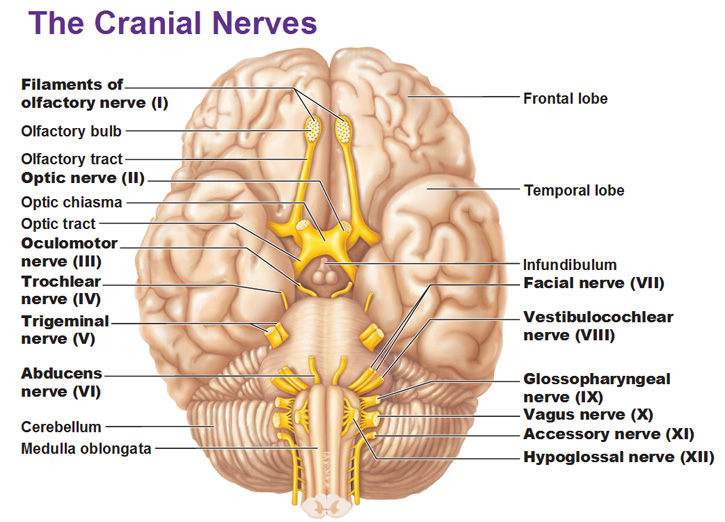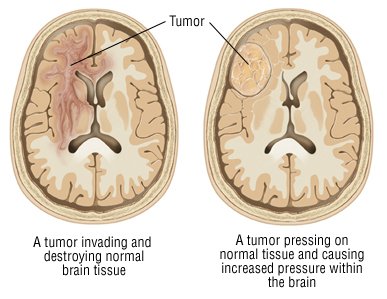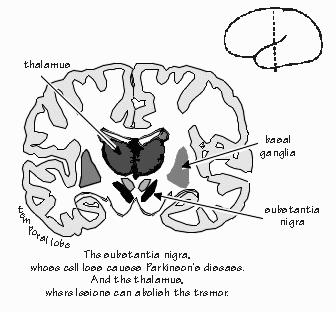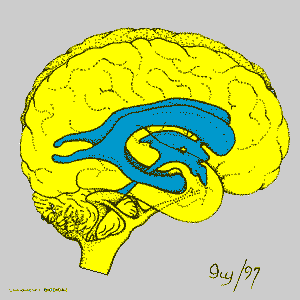This week, we focused on the 12 pairs of cranial nerves and what they do.
Here are some interesting things we noticed:
- Sheep, cats, and humans all have the same 12 pairs of cranial nerves. The size can be a bit different, like the olfactory nerves are proportionately larger in smell-oriented animals than humans, but the location and function of the nerves is pretty much the same.
- Three of the 12 are motor nerves for the eye muscles. They move the eyeballs in different directions. I guess this must be very important.
- Two of the 12 are involved in taste sensation: one for taste at the tip of the tongue and one for taste in the back of the tongue.
- Some of them are sensory, which means they are transmitting sense information from the sense organ (eye, ear, nose, tongue) to the part of the brain that deals with that information. Some of them are motor, which means they are transmitting a signal from the brain to a muscle to tell that muscle to move. Some of the nerves are bundles of axons that have a sensory part and a motor part, so they are considered both sensory and motor nerves.
- The numbering of the cranial nerves is in roman numerals. They are numbered I through XII (1 - 12) starting from the front of the brain and moving towards the back of the brain (looking down at the underside of the brain).
- The names of the nerves are:
- I: Olfactory: smell information going from nose to brain
- II: Optic: visual information going from eyes to brain
- III: Oculomotor: moves your eyeball and constricts pupil
- IV: Trochlear: moves your eyeball (downward and in towards your nose)
- V: Trigeminal: senses touch from the face and head, and moves your jaw for chewing
- VI: Abducens: moves your eyeball (side to side)
- VII: Facial: taste information going from front of tongue to brain, muscles of facial expressions
- VIII: Vestibulocochlear: hearing and balance information going from ear to brain
- IX: Glossopharyngeal: taste information from back of tongue, and swallowing movement
- X: Vagus: sense and movement in your glands and digestive system
- XI: (Spinal) Accessory: controls muscles for head movement
- XII: Hypoglossal: controls tongue muscles
- There are lots of mnemonics for the cranial nerves. A mnemonic is something you use to remember something (often a list of things). Typically, you make a phrase that you can remember that uses the first letter of each item on the list. For the cranial nerves, here are some of the mnemonics I found:
- Odor Of Orangutan Terrified Tarzan After Forty Voracious Gorillas Viciously Attacked Him
- On Occasion Our Trusty Truck Acts Funny, Very Good Vehicle Any How
- Once One Openly Told Tourists About Fighting Vampires Gobling Various Antelope Herds
- Only Owls Observe Them Traveling And Finding Voldemort Guarding Very Secret Horcruxes
- Old Opie Occasionally Tries Trigonometry And Feels Very Gloomy, Vague And Hypoactive
- Old Oprah Occasionally Trots Triumphantly About, Farting Velveeta Globs, Vaunting Accolades Hysterically
- Once On October Thirteenth, Troublesome Abductors Filched Various Golden Valuables And Heirlooms
- Old Oppressive Oceanic Trout Trick Aquatic Fauna Very Greedily; Valiant Sharks Hunt
(them).
- Oh Once One Takes The Anatomy Final, Very Good Vacations Are Heavenly.
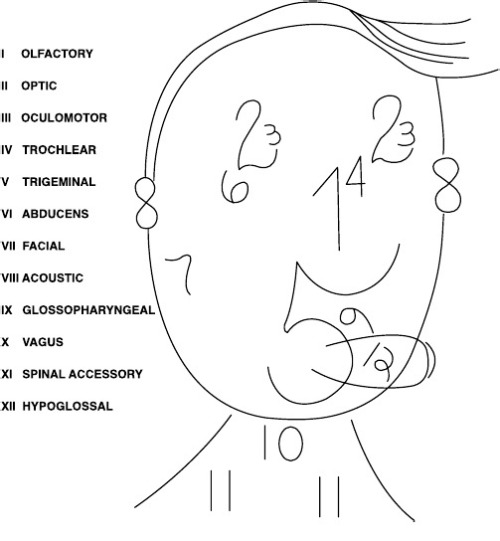 |
| A visual mnemonic for the cranial nerves! |
- Here's one I just made up: Often, one opens the top and front velcro, giving villains a hand.
- There are also mnemonics to help you remember which ones are sensory (S), which are motor (M), and which are both (B).
- Some Say Marry Money, But My Brother Says Big Brains Matter Most
- Silly Superman Made Mortal Brothers Make Bets Since Both Boys Made Money
- Some Say Money Matters, But My Beloved Says Being Beloved Matters More
- Here's one I just made up now: Share Some Merry Music By Making Brother Shake Both Bongos Mighty Madly
Testing the Cranial Nerves
In class, we did activities to illustrate what daily activities use which cranial nerves.
For the Olfactory Nerve (Cranial Nerve I), we had four boxes that each contained a cotton ball with a scented liquid on it. We each sniffed the cotton ball, then guessed what the smell was. The four scents were:

- vanilla (we discussed why it smells like alcohol -- because the vanilla beans don't dissolve in water, so alcohol is used to get the flavor into a useful form)
- orange extract
- vinegar
- lemon extract
For the Optic Nerve (Cranial Nerve II) we took an eye test. Students in the class have excellent eyesight!
For the Oculomotor, Trochlear, and Abducens Nerves (Cranial Nerves III, IV, and VI) we moved our eyes in all directions, tracking the movements of my finger without moving the head.
For the Trigeminal Nerve (Cranial Nerve V), we ate some food -- using the muscles that move our jaws to chew -- and I also touched each student's cheeks with a cotton ball.
 |
| Making faces -- cranial nerve VII |
For the Facial Nerve (Cranial Nerve VII), we made funny faces and also tasted brownies with the front parts of our tongues.
For the Vestibulocochlear Nerve (Cranial Nerve VIII), we tested our hearing by closing our eyes and raising hands when we hear a quiet snap across the room. Excellent hearing in all the students. Then, we balanced on one foot and closed our eyes. No one fell down!
For the Glossopharyngeal Nerve (Cranial Nerve IX), we swallowed a sip of water.
We forgot to do anything with the Vagus Nerve (Cranial Nerve X) because the website we looked at didn't show anything. But of course we were using our Vagus Nerve as we digested the foods we were eating! Students brought bloody rice krispie treats, eyeball mozzarella balls, and breadstick fingers with almond fingernails. Brownies and carrots were there to balance it out.
For the Spinal Accessory Nerve (Cranial Nerve XI), we partnered up and had one person put their hands on the side of the other's head. The partner then tried to move their head side to side.
For the Hypoglossal Nerve (Cranial Nerve XII), we all stuck out our tongues, moved them to the right, then to the left, then back into our mouths.
We all passed with flying colors, and appear to have healthy cranial nerves!!






